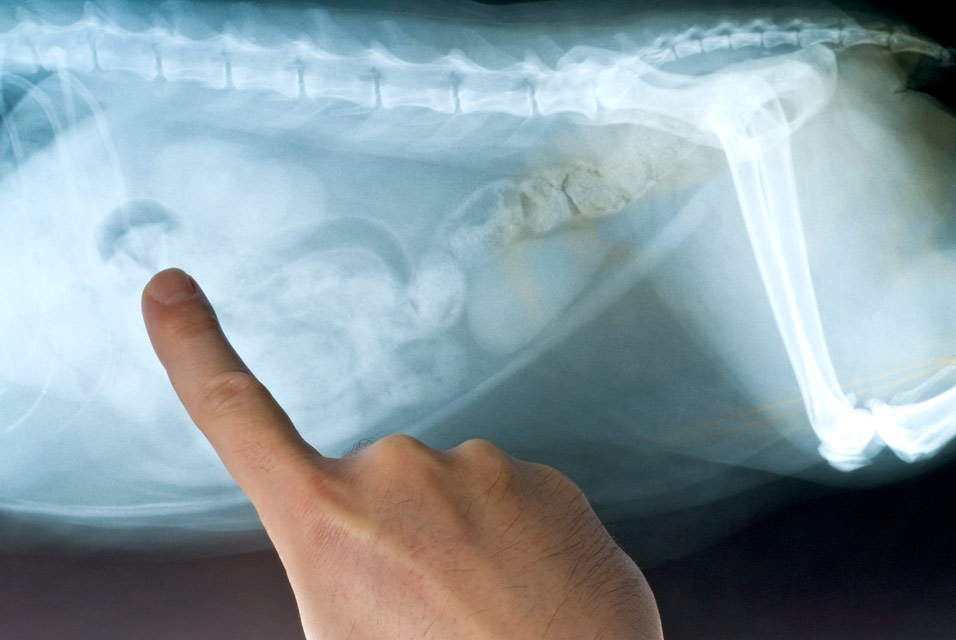X-Rays in Cats: What They Can Tell Your Vet

Radiography, or x-ray, is one of the most common diagnostic procedures performed on cats. Most veterinarians are able to perform x-rays in their clinic.
What Are X-Rays and How Are They Performed?
During an x-ray, a machine directs electromagnetic radiation through a specific area of a cat's body and onto a film, creating a picture. Today, it's possible to perform digital x-rays, where the image is computerized rather than on a physical piece of film.
During x-rays, the cat must be still, and the people performing the procedure will position her so that the x-ray beam will travel through the part of the body of interest. That body part is then measured so the x-ray machine can be programmed.
Many times, cats can stay awake for x-rays because they don't need to be perfectly still for very long for the x-ray to be taken. However, if the cat needs to be in a complicated position for the x-ray, is painful when manipulated into position, or is aggressive, she might require anesthesia.
Most of the time, areas of the cat's body that are not to be x-rayed are covered with lead aprons to reduce the amount of radiation the cat is exposed to. Any people who are in the room for restraint must wear lead aprons, gloves, glasses, and thyroid shields to reduce the amount of radiation they are exposed to. They also wear monitors on the outside of their lead. The monitors are tested periodically to ensure the person hasn't been exposed to high levels of radiation.
What Are X-Rays Used for in Cats?
The most common areas of the body that are x-rayed in cats are listed here.
- Thorax (chest): to evaluate respiratory conditions like asthma, bronchitis, and pneumonia, heart conditions, broken ribs, and to look for fluid and tumors within the chest cavity.
- Abdomen (belly): to look for problems with the organs and space in the abdomen, including the kidneys, liver, intestines, bladder, and uterus.
- Extremities: to examine bones and joints.
- Teeth: a special machine is used to take dental x-rays that can examine the roots of the teeth and other issues that might occur below the gum line, where a lot of disease can hide.
Sometimes a dye study is done, which can further aid in visibility and diagnosis of certain conditions. One common situation in which dye is used for plain x-ray studies is when a pet is given barium by mouth and then serial x-rays are taken of the abdomen to watch the barium move through the intestinal tract. This can help diagnose intestinal obstructions or partial obstructions.
What Are the Drawbacks of Feline X-Rays?
In general, x-rays can provide extremely useful information on many conditions. It is a non-invasive procedure that is fairly safe. The small amounts of radiation used to obtain the images is not considered dangerous when done infrequently. If anesthesia is necessary to get quality images, the potential dangers involved with that are present. If dye is used, the risk of potential dye allergy is present.
Some conditions can't be diagnosed with x-rays alone. For instance, small changes in organ tissue won't show up on x-rays. Also, sometimes a problem can be spotted, but many things could cause the tissue to look that way. For instance, fluid in the chest cavity can be seen on an x-ray, but further testing will be necessary to determine what the fluid is and why it's there.
Therefore, x-rays sometimes need to be followed by other testing like fine needle aspiration, MRI, CT scan, or ultrasound to get more information and make a diagnosis. However, sometimes x-ray is all that's required, as in the case of many bone fractures, some intestinal obstructions, and the presence of bladder or kidney stones (though the type of stone will still not be known until the stones can be removed and tested).
You May Also Like These Articles:
Common Blood Tests Done on Cats
Fine Needle Aspiration: FNA in Cats
MRI in Cats: What Is It and Why Might Your Cat Need It?
Causes of Unexplained Weight Loss in Cats
Notice: Ask-a-Vet is an affiliated service for those who wish to speak with a veterinary professional about their pet's specific condition. Initially, a bot will ask questions to determine the general nature of your concern. Then, you will be transferred to a human. There is a charge for the service if you choose to connect to a veterinarian. Ask-a-Vet is not manned by the staff or owners of CatHealth.com, and the advice given should not delay or replace a visit to your veterinarian.





